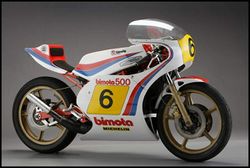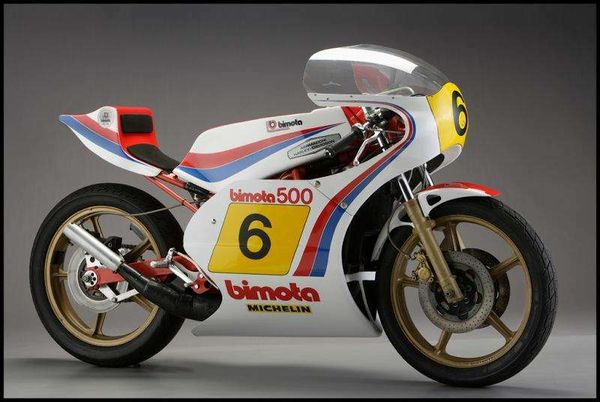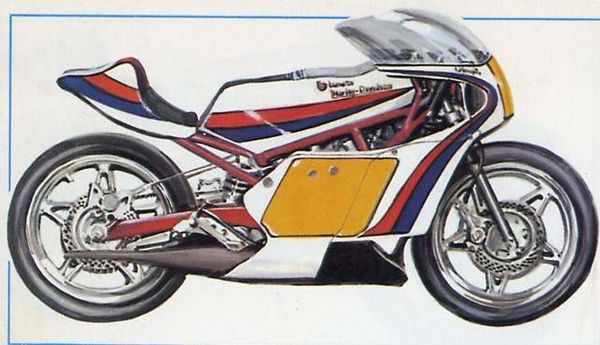Bimota Harley Davidson 500
 |
|
| Racing Bikes Bimota Harley Davidson 500 | |
| Class | Racing |
|---|---|
| Weight | |
| Manuals | Service Manual |
Photos[edit | edit source]
Overview[edit | edit source]
Bimota Harley-Davidson 500
The Varese branch of Harley-Davidson had a world champion in
the 250 class and had derived a two-cylinder 350 from it. At the beginning of
the 1975 season the company put a new 500 into the field.
This was the period in which Phil Read's MV Agusta 500 had
serious problems with rear stability, because the rear wheel jumped during
braking. Harley-Davidson avoided this problem with its 500 model by mounting a
rear disk brake on the end of the transmission pin, a solution that was widely
applied to automobiles. Another striking feature of the 500 was the fact that it
had four carburetors, even though there were only two cylinders.
This experimental engine was used occasionally on racing
motorcycles by Walter Villa, and it was later mounted on the Bimota. That
company took over the engine and made a new chassis for it. Bimota gave the
Harley-Davidson 500 the same type of openwork chassis that had been designed for the Suzuki 500. The fork fulcrum was on the axle of the secondary transmission shaft and the rear suspension was "monocross" with a Koni automobile shock absorber. There were replaceable cams on the upper plate of the steering mechanism. The new motorcycle was ridden by Vanes Francini, the official Bimota racer. Motorcycle: Bimota-Harley-Davidson 500 Manufacturer: Bimota s.n.c, Rimini Type: Racing Year: 1976 Engine: Harley-Davidson two-cylinder, two-stroke, with cross-port distribution. Two carburetors per cylinder. Displacement 500 cc. Cooling: Water Transmission: Six-speed block Power: About 90 h.p. Maximum speed: Chassis: Openwork, tubular. Front, telescopic suspension, adjustable; rear, monocross with single central shock absorber Brakes: Front, double hydraulic disk; rear, single hydraulic disk
1976 BIMOTA HDB1 500
This is a unique model, of great interest for the technical solutions that were
employed to construct it. It all began in the mid 1970s, when the Sports
Department of Schirannas Aermacchi/Harley-Davidson aimed towards the 500 class.
After the excellent results obtained on the racetrack with the 2-stroke 250 and
350, a 391 cc was developed which in the hands of Granfranco Bonera proved to be
a tough competitor for the Suzuki and MV Agusta 4 cylinders. In light of the
prestigious results a full capacity model was developed with a new 2- cylinder
engine that was characterized by a 4-carburetor fuel supply. With this engine a
series of about 10 motorcycles were produced for the Sports Department, but
thanks to the earlier collaborations with Bimota, an engine was presented to the
Rimini based manufacturer. The great designer Massimo Tamburini provided a
special frame, with a perimetral structure and high resistance chromo-molybdenum
steel tubes. The fork (made from boxed Avional!) is extremely interesting, and
extends along the side of the engine to become coaxial with the exit of the
pinion in order to not affect the movement of the chain. But the most
fascinating feature is certainly the rear suspension that has a cantilever
system with a single central cushioning. This is universally employed today but
it was a real novelty in 1976. In fact, at the time the only manner to acquire
such a component was to enter into the world of Formula 1! The spring is
original Bimota and is made from titanium, the cushioning is a Koni, which is
identical to, that used on the Ferrari 312/T. Amongst the other original
characteristics: the wheel trail can be adjusted through the plates at the head
of the fork and the Bimota designed rims are in magnesium. A truly revolutionary
Grand Prix bike.

